Does Ecotourism Really Benefit the Environment? A Trend Analysis of Forest Cover Loss in Indonesia
Abstract
1. Introduction
2. Literature Review
2.1. Global Perspective on Ecotourism Outcomes
2.2. Ecotourism Benefits to the Environment in Indonesia
2.3. Methodological Approaches to Assessing Ecotourism
3. Materials and Methods
3.1. Study Area
3.2. Forest Cover Calculation on Ecotourism Sites
3.3. Counterfactual Analysis of Forest Loss
3.4. Trend Analysis of Forest Loss Change
3.5. Statistical Analysis
4. Results
4.1. Forest Loss Trends by Distance, Conservation Area, and Region
4.2. Counterfactual Analysis of Ecotourism Sites and Non-Ecotourism Sites
4.3. Comparison of Ecotourism Sites with National Forest Loss Trends
5. Discussion
5.1. Ecotourism Impact on Forest Loss in Indonesia
5.2. Regional Variation in Ecotourism’s Effectiveness
5.3. Conservation Area Types and Forest Loss Trends Around Ecotourism Areas
5.4. Site-Specific Ecotourism Strategies and Their Correlation to Forest Conservation
5.5. Implication to Ecotourism Planning and Policy
5.6. Limitation and Future Studies
6. Conclusions
Author Contributions
Funding
Data Availability Statement
Conflicts of Interest
Appendix A
| No | Province | Name | Latitude | Longitude | Conservation Area | Distance Significant Detected | Significant Trend |
|---|---|---|---|---|---|---|---|
| Sumatera | |||||||
| 1 | Aceh | Wisata Hutan Mangrove Kota Langsa | 4.521636 | 98.0162 | Protected Forest | 3 km | Decrease |
| 2 | Aceh | Teupin Layeu | 5.871526 | 95.25749 | Nature Recreational Park | 12 km | Decrease |
| 3 | North Sumatera | Toba Caldera Resort | 2.6075849 | 98.94648 | Protected Forest | 6 km, 15 km | Decrease |
| 4 | North Sumatera | Bat Cave Bukit Lawang | 3.535454 | 98.11727 | National Park | 3 km, 6 km, 9 km | Increase |
| 5 | North Sumatera | Air Terjun Sikulikap | 3.2454292 | 98.53399 | National Park | 3 km | Increase |
| 6 | North Sumatera | Air Terjun Sipitu-Pitu | 1.686052 | 98.94605 | Protected Forest | 1 km | Increase |
| 7 | West Sumatera | Lawang Adventure Park | −0.280778 | 100.2416 | Protected Forest | 6 km, 9 km | Increase |
| 8 | West Sumatera | Lembah Anai Waterfall | −0.483611 | 100.3384 | Nature Forest Reserve | 15 km | Increase |
| 9 | West Sumatera | Objek Wisata Taman Suaka Alam Rimbo Panti | 0.3463983 | 100.06914 | Nature Recreational Park | 3 km, 9 km, 15 km | Decrease |
| 10 | West Sumatera | Siberut Island National Park | −1.317489 | 98.88916 | National Park | 6 km | Increase |
| 11 | Jambi | Berbak National Park | −1.286865 | 104.2396 | National Park | 9 km, 15 km | Decrease |
| 12 | West Sumatera | Kerinci Seblat National Park | −1.70422 | 101.26899 | National Park | 3 km, 9 km | Both |
| 13 | Jambi | Air Terjun Telun Berasap | −1.689885 | 101.3397 | National Park | 15 km | Decrease |
| 14 | South Sumatera | Puntikayu Amusement Palembang | −2.943726 | 104.7283 | Nature Recreational Park | 12 km, 15 km | Decrease |
| 15 | South Sumatera | Taman Nasional Sembilang | −2.035627 | 104.6593 | National Park | 15 km | Decrease |
| 16 | Lampung | Camp Ground Danau Lebar Suoh | −5.247633 | 104.2706 | National Park | 6 km | Decrease |
| 17 | Lampung | Way Kambas National Park | −4.927576 | 105.7769 | National Park | 12 km | Decrease |
| 18 | Lampung | Taman Nasional Bukit Barisan Selatan | −5.448473 | 104.3516 | National Park | 6 km, 9 km | Decrease |
| 19 | Lampung | Nirwana Keramikan | −5.237233 | 104.2593 | National Park | 6 km | Decrease |
| 20 | Lampung | Wana Wisata Tanjung Harapan | −5.224397 | 104.7919 | Protected Forest | 3 km, 6 km | Decrease |
| Bali & Nusa Tenggara | |||||||
| 21 | Bali | West Bali National Park | −8.127611 | 114.4753 | National Park | 15 km | Increase |
| 22 | Bali | Bali Botanical Garden | −8.276122 | 115.1542 | Protected Forest | 3 km, 9 km | Increase |
| 23 | West Nusa Tenggara | Air Terjun Tibu Bunter | −8.536218 | 116.2599 | Grand Forest Park | 15 km | Increase |
| 24 | East Nusa Tenggara | Kelimutu National Park | −8.741548 | 121.7936 | National Park | 15 km | Decrease |
| 25 | East Nusa Tenggara | Pantai Litianak | −10.75517 | 122.8999 | Protected Forest | 15 km | Decrease |
| 26 | East Nusa Tenggara | Wolokoro Ecotourism | −8.81706 | 120.9341 | Nature Forest Reserve | 6 km, 9 km, 12 km | Decrease |
| 27 | East Nusa Tenggara | Taman Wisata Alam Menipo | −10.14851 | 124.1491 | Nature Recreational Park | 15 km | Decrease |
| Kalimantan | |||||||
| 28 | West Kalimantan | Sentarum Lake National Park | 0.8303082 | 112.1769 | National Park | 9 km, 12 km | Decrease |
| 29 | Central Kalimantan | Camp Leakey | −2.760856 | 111.9448 | National Park | 15 km | Decrease |
| 30 | Central Kalimantan | Taman Nasional Tanjung Puting | −3.055015 | 111.9184 | National Park | 6 km, 9 km, 12 km, 15 km | Decrease |
| 31 | South Kalimantan | Taman Wisata Alam Pulau Bakut | −3.215241 | 114.5576 | Nature Recreational Park | 6 km, 9 km, 12 km | Decrease |
| 32 | South Kalimantan | Jeram Alam Roh Tujuh Belas | −3.419173 | 115.1415 | Grand Forest Park | 3 km, 6 km, 9 km | Decrease |
| 33 | South Kalimantan | Bukit Matang Kaladan | −3.525424 | 115.0094 | Grand Forest Park | 9 km | Decrease |
| 34 | South Kalimantan | Mandin Mangapan | −2.860428 | 115.5502 | Protected Forest | 6 km, 9 km, 12 km | Decrease |
| 35 | South Kalimantan | Taman Hutan Raya Sultan Adam | −3.519414 | 114.9501 | Nature Reserve and Nature Preservation Forest | 1 km | Decrease |
| 36 | Central Kalimantan | Hutan Lindung Sei Wain | −1.145255 | 116.8397 | Protected Forest | 1 km | Decrease |
| 37 | East Kalimantan | Wisata Alam Prevab Tnkutai | 0.5315004 | 117.4653 | National Park | 3 km | Decrease |
| Sulawesi | |||||||
| 38 | North Sulawesi | Ekowisata Mangrove Desa Bahoi | 1.7180899 | 125.02 | Protected Forest | 12 km | Decrease |
| 39 | North Sulawesi | Tangkoko Batuangus Nature Reserve | 1.5082463 | 125.1882 | Nature Forest Reserve | 9 km | Increase |
| 40 | North Sulawesi | Pantai Lakban Ratatotok | 0.8492183 | 124.7087 | Protected Forest | 12 km | Decrease |
| 41 | North Sulawesi | Obyek Wisata Pantai Batu Pinagut | 0.9202904 | 123.2694 | Protected Forest | 12 km | Decrease |
| 42 | South Sulawesi | Ide Beach | −2.51529 | 121.3423 | Nature Recreational Park | 9 km, 15 km | Decrease |
| 43 | South Sulawesi | Air Terjun Sarambu Ala | −2.704501 | 120.1323 | Protected Forest | 3 km, 6 km, 9 km | Decrease |
| 44 | Southeast Sulawesi | Taman Nasional Rawa Aopa Watumohai | −4.438332 | 121.8733 | National Park | 6 km, 9 km, 12 km | Decrease |
| 45 | Southeast Sulawesi | Air Panas Wawolesea | −3.696262 | 122.3033 | Protected Forest | 12 km | Decrease |
| 46 | Gorontalo | Ilomata River Camp | 0.6988795 | 123.1824 | National Park | 3 km, 6 km, 9 km | Decrease |
| Maluku & Papua | |||||||
| 47 | Papua | Pantai Wagi | −3.380823 | 135.1236 | National Park | 6 km | Decrease |
References
- Schmitt, S.; Raevel, V.; Réjou-Méchain, M.; Ayyappan, N.; Balachandran, N.; Barathan, N.; Rajashekar, G.; Munoz, F. Canopy and Understorey Tree Guilds Respond Differently to the Environment in an Indian Rain Forest. J. Veg. Sci. 2021, 32, e13075. [Google Scholar] [CrossRef]
- Wade, C.M.; Austin, K.G.; Cajka, J.; Lapidus, D.; Everett, K.H.; Galperin, D.; Maynard, R.; Sobel, A. What Is Threatening Forests in Protected Areas? A Global Assessment of Deforestation in Protected Areas, 2001–2018. Forests 2020, 11, 539. [Google Scholar] [CrossRef]
- van Wees, D.; van der Werf, G.R.; Randerson, J.T.; Andela, N.; Chen, Y.; Morton, D.C. The Role of Fire in Global Forest Loss Dynamics. Glob. Chang. Biol. 2021, 27, 2377–2391. [Google Scholar] [CrossRef] [PubMed]
- Ramachandran, N.; Irvin, J.; Sheng, H.; Johnson-Yu, S.; Story, K.; Rustowicz, R.; Ng, A.Y.; Austin, K. Automatic Deforestation Driver Attribution Using Deep Learning on Satellite Imagery. Glob. Environ. Chang. 2024, 86, 102843. [Google Scholar] [CrossRef]
- Austin, K.G.; Baker, J.S.; Sohngen, B.L.; Wade, C.M.; Daigneault, A.; Ohrel, S.B.; Ragnauth, S.; Bean, A. The Economic Costs of Planting, Preserving, and Managing the World’s Forests to Mitigate Climate Change. Nat. Commun. 2020, 11, 5946. [Google Scholar] [CrossRef] [PubMed]
- Knoke, T.; Hanley, N.; Roman-Cuesta, R.M.; Groom, B.; Venmans, F.; Paul, C. Trends in Tropical Forest Loss and the Social Value of Emission Reductions. Nat. Sustain. 2023, 6, 1373–1384. [Google Scholar] [CrossRef]
- Honey, M. Community Conservation and Early Ecotourism: Experiments in Kenya. Environ. Sci. Policy Sustain. Dev. 2009, 51, 46–57. [Google Scholar] [CrossRef]
- Stronza, A.; Pêgas, F. Ecotourism and Conservation: Two Cases from Brazil and Peru. Hum. Dimens. Wildl. 2008, 13, 263–279. [Google Scholar] [CrossRef]
- Margono, B.A.; Potapov, P.V.; Turubanova, S.; Stolle, F.; Hansen, M.C. Primary Forest Cover Loss in Indonesia over 2000–2012. Nat. Clim. Chang. 2014, 4, 730–735. [Google Scholar] [CrossRef]
- Brandt, J.S.; Buckley, R.C. A Global Systematic Review of Empirical Evidence of Ecotourism Impacts on Forests in Biodiversity Hotspots. Curr. Opin. Environ. Sustain. 2018, 32, 112–118. [Google Scholar] [CrossRef]
- Okech, R.N. Ecotourism Development and Challenges: A Kenyan Experience. Tour. Anal. 2011, 16, 19–30. [Google Scholar] [CrossRef]
- Mondino, E.; Beery, T. Ecotourism as a Learning Tool for Sustainable Development. The Case of Monviso Transboundary Biosphere Reserve, Italy. J. Ecotourism 2019, 18, 107–121. [Google Scholar] [CrossRef]
- Zambrano, A.M.A.; Broadbent, E.N.; Durham, W.H. Social and Environmental Effects of Ecotourism in the Osa Peninsula of Costa Rica: The Lapa Rios Case. J. Ecotourism 2010, 9, 62–83. [Google Scholar] [CrossRef]
- Almeyda, A.M.; Broadbent, E.N.; Wyman, M.S.; Durham, W.H. Ecotourism Impacts in the Nicoya Peninsula, Costa Rica. J. Tour. Res. 2010, 12, 803–819. [Google Scholar] [CrossRef]
- Stem, C.J.; Lassoie, J.P.; Lee, D.R.; Deshler, D.J. How “Eco” Is Ecotourism? A Comparative Case Study of Ecotourism in Costa Rica. J. Sustain. Tour. 2003, 11, 322–347. [Google Scholar] [CrossRef]
- Kiss, A. Is Community-Based Ecotourism a Good Use of Biodiversity Conservation Funds? Trends Ecol. Evol. 2004, 19, 232–237. [Google Scholar] [CrossRef]
- Campbell-Hunt, D.M. Ecotourism and Sustainability in Community-Driven Ecological Restoration: Case Studies from New Zealand. WIT Trans. Ecol. Environ. 2008, 115, 231–240. [Google Scholar]
- Ali, A.; Isa, S.S.; Isa, S.S.; Isa, M.H. Ecotourism Promotes Conservation Activity at Tourism Destinations: Limestone Forest Langkawi. Environ.-Behav. Proc. J. 2021, 6, 107–113. [Google Scholar] [CrossRef]
- Svoronou, E.; Holden, A. Ecotourism as a Tool for Nature Conservation: The Role of WWF Greece in the Dadia-Lefkimi-Soufli Forest Reserve in Greece. J. Sustain. Tour. 2005, 13, 456–467. [Google Scholar] [CrossRef]
- Butarbutar, R.R.; Soemarno, S. Community Empowerment Efforts in Sustainable Ecotourism Management in North Sulawesi, Indonesia. Indones. J. Environ. Sustain. Dev. 2012, 3. [Google Scholar]
- Kinnaird, M.F.; O’Brien, T.G. Ecotourism in the Tangkoko DuaSudara Nature Reserve: Opening Pandora’ Box? Oryx 1996, 30, 65–73. [Google Scholar] [CrossRef]
- Satyatama, T.; Faida, L.R.W.; Purwanto, R.H.; Fandeli, C. Carving The Future of Nature Ecotourism in Indonesia: Case of Taman Wisata Alam Telogo Warno Telogo Pengilon. J. Manaj. Hutan Trop. 2020, 26, 80–89. [Google Scholar] [CrossRef]
- Surya, A.P. The Role of Ecotourism in Promoting Sustainable Economic Development in Indonesia. JWE 2024, 3, 43–48. [Google Scholar] [CrossRef]
- Antari, N.P.B.W.; Connell, D. Tukad Bindu in Bali, Indonesia: Ecotourism or Greenwashing? Int. J. Tour. Cities 2021, 7, 1049–1075. [Google Scholar] [CrossRef]
- Anggraini, R.I.; Gunawan, B. Ecotourism Development in National Parks: A New Paradigm of Forest Management in Indonesia. E3S Web Conf. 2021, 249, 03010. [Google Scholar] [CrossRef]
- Satrya, I.D.G.; Kaihatu, T.S.; Budidharmanto, L.P.; Karya, D.F.; Rusadi, N.W.P. The Role of Ecotourism in Preserving Environmental Awareness, Cultural and Natural Attractiveness for Promoting Local Communities in Bali, Indonesia. J. East. Eur. Cent. Asian Res. 2023, 10, 1063–1075. [Google Scholar] [CrossRef]
- Chaplin, J.; Brabyn, L. Using Remote Sensing and GIS to Investigate the Impacts of Tourism on Forest Cover in the Annapurna Conservation Area, Nepal. Appl. Geogr. 2013, 43, 159–168. [Google Scholar] [CrossRef]
- Setyowati, H.A.; Dwinugroho, M.P.; Murti, B.S.S.H.; Yulianto, A.; Ajiwihanto, N.E.; Hadinata, J.; Sanjiwana, A.K. ESDM One Map Indonesia Indonesia: Opportunities and Challenges to Support One Map Policy Based on Applied Web-GIS. IOP Conf. Ser. Earth Environ. Sci. 2018, 165, 012021. [Google Scholar] [CrossRef]
- Rahman, A. Agricultural Transformation in Indonesia: Evaluation of Policy Implementation and Challenges Faced. J. Ilm. Ilmu Adm. Publik 2022, 12, 691–700. [Google Scholar] [CrossRef]
- Brandt, J.S.; Radeloff, V.; Allendorf, T.; Butsic, V.; Roopsind, A. Effects of Ecotourism on Forest Loss in the Himalayan Biodiversity Hotspot Based on Counterfactual Analyses. Conserv. Biol. 2019, 33, 1318–1328. [Google Scholar] [CrossRef]
- Martha, S. The Analysis of Geospatial Information for Validating Some Numbers of Islands in Indonesia. Indones. J. Geogr. 2017, 49, 204–211. [Google Scholar] [CrossRef]
- Hansen, M.C.; Potapov, P.V.; Moore, R.; Hancher, M.; Turubanova, S.A.; Tyukavina, A.; Thau, D.; Stehman, S.V.; Goetz, S.J.; Loveland, T.R.; et al. High-Resolution Global Maps of 21st-Century Forest Cover Change. Science 2013, 342, 850–853. [Google Scholar] [CrossRef]
- Zhang, D.; Wang, H.; Wang, X.; Lü, Z. Accuracy Assessment of the Global Forest Watch Tree Cover 2000 in China. Int. J. Appl. Earth Obs. Geoinf. 2020, 87, 102033. [Google Scholar] [CrossRef]
- Souza, C.; Tenneson, K.; Dilger, J.; Wespestad, C.; Bullock, E. Forest Degradation and Deforestation. In Cloud-Based Remote Sensing with Google Earth Engine: Fundamentals and Applications; Cardille, J.A., Crowley, M.A., Saah, D., Clinton, N.E., Eds.; Springer International Publishing: Cham, Switzerland, 2024; pp. 1061–1091. ISBN 978-3-031-26588-4. [Google Scholar]
- Sisriany, S.; Furuya, K. Understanding the Spatial Distribution of Ecotourism in Indonesia and Its Relevance to the Protected Landscape. Land 2024, 13, 370. [Google Scholar] [CrossRef]
- MoF (Ministry of Forestry of Indonesia). Consolidation Report: Reducing Emissions from Deforestation and Forest Degradation in Indonesia; Forestry Research and Development Agency (FORDA): Jakarta, Indonesia, 2008. [Google Scholar]
- Ribas, L.G.S.; Pressey, R.L.; Bini, L.M. Estimating Counterfactuals for Evaluation of Ecological and Conservation Impact: An Introduction to Matching Methods. Biol. Rev. 2021, 96, 1186–1204. [Google Scholar] [CrossRef]
- Jones, K.W.; Lewis, D.J. Estimating the Counterfactual Impact of Conservation Programs on Land Cover Outcomes: The Role of Matching and Panel Regression Techniques. PLoS ONE 2015, 10, e0141380. [Google Scholar] [CrossRef]
- Fiorini, A.C.O.; Mullally, C.; Swisher, M.; Putz, F.E. Forest Cover Effects of Payments for Ecosystem Services: Evidence from an Impact Evaluation in Brazil. Ecol. Econ. 2020, 169, 106522. [Google Scholar] [CrossRef]
- Reygadas, Y.; Jensen, J.L.R.; Moisen, G.G. Forest Degradation Assessment Based on Trend Analysis of MODIS-Leaf Area Index: A Case Study in Mexico. Remote Sens. 2019, 11, 2503. [Google Scholar] [CrossRef]
- Santos, C.A.G.; Do Nascimento, T.V.M.; Da Silva, R.M. Analysis of Forest Cover Changes and Trends in the Brazilian Semiarid Region between 2000 and 2018. Environ. Earth Sci. 2020, 79, 418. [Google Scholar] [CrossRef]
- Frimpong, B.F.; Koranteng, A.; Molkenthin, F. Analysis of Temperature Variability Utilising Mann–Kendall and Sen’s Slope Estimator Tests in the Accra and Kumasi Metropolises in Ghana. Env. Syst. Res. 2022, 11, 24. [Google Scholar] [CrossRef]
- Lin, Y.; Zuo, X.; Weng, A.; Nizamani, M.M.; Jin, Y.; Wen, L.; Zhao, Q.; Li, B. Insight into the Imbalance of Forest Cover Change at County Level in Mainland China during 2000–2020: From the Perspective of Subdividing Forest Cover Change into Forest Gain and Loss. J. Clean. Prod. 2024, 453, 142238. [Google Scholar] [CrossRef]
- Pohlert, T. Trend: Non-Parametric Trend Tests and Change-Point Detection 2015, (Version 1.1.6) [R package]. Comprehensive R Archive Network (CRAN). Available online: https://CRAN.R-project.org/package=trend (accessed on 1 March 2025).
- Brandt, J.; Ertel, J.; Spore, J.; Stolle, F. Wall-to-Wall Mapping of Tree Extent in the Tropics with Sentinel-1 and Sentinel-2. Remote Sens. Environ. 2023, 292, 113574. [Google Scholar] [CrossRef]
- Gaveau, D.L.A.; Sheil, D.; Husnayaen; Salim, M.A.; Arjasakusuma, S.; Ancrenaz, M.; Pacheco, P.; Meijaard, E. Rapid Conversions and Avoided Deforestation: Examining Four Decades of Industrial Plantation Expansion in Borneo. Sci. Rep. 2016, 6, 32017. [Google Scholar] [CrossRef]
- Purnomo, M.; Maryudi, A.; Andriatmoko, N.D.; Jayadi, E.M.; Faust, H. The Cost of Leisure: The Political Ecology of the Commercialization of Indonesia’s Protected Areas. Environ. Sociol. 2022, 8, 121–133. [Google Scholar] [CrossRef]
- Li, Y.; Zhang, L.; Gao, Y.; Huang, Z.; Cui, L.; Liu, S.; Fang, Y.; Ren, G.; Fornacca, D.; Xiao, W. Ecotourism in China, Misuse or Genuine Development? An Analysis Based on Map Browser Results. Sustainability 2019, 11, 4997. [Google Scholar] [CrossRef]
- Atieno, L.; Njoroge, J.M. The Ecotourism Metaphor and Environmental Sustainability in Kenya. Tour. Hosp. Res. 2015, 18, 49–60. [Google Scholar] [CrossRef]
- Büscher, B.; van den Bremer, R.; Fletcher, R.; Koot, S. Authenticity and the Contradictions of the “Ecotourism Script”: Global Marketing and Local Politics in Ghana. Crit. Arts 2017, 31, 37–52. [Google Scholar] [CrossRef]
- Dang, T.K.P. Green Nature or Green Fantasies: Representations of Ecotourism in Vietnam. Sustainability 2023, 15, 4601. [Google Scholar] [CrossRef]
- Austin, K.G.; Schwantes, A.; Gu, Y.; Kasibhatla, P.S. What Causes Deforestation in Indonesia? Environ. Res. Lett. 2019, 14, 024007. [Google Scholar] [CrossRef]
- Meijaard, E.; Brooks, T.M.; Carlson, K.M.; Slade, E.M.; Garcia-Ulloa, J.; Gaveau, D.L.A.; Lee, J.S.H.; Santika, T.; Juffe-Bignoli, D.; Struebig, M.J.; et al. The Environmental Impacts of Palm Oil in Context. Nat. Plants 2020, 6, 1418–1426. [Google Scholar] [CrossRef]
- Santika, T.; Meijaard, E.; Budiharta, S.; Law, E.A.; Kusworo, A.; Hutabarat, J.A.; Indrawan, T.P.; Struebig, M.; Raharjo, S.; Huda, I.; et al. Community Forest Management in Indonesia: Avoided Deforestation in the Context of Anthropogenic and Climate Complexities. Glob. Environ. Chang. 2017, 46, 60–71. [Google Scholar] [CrossRef]
- Bruner, A.G.; Gullison, R.E.; Rice, R.E.; Da Fonseca, G.A.B. Effectiveness of Parks in Protecting Tropical Biodiversity. Science 2001, 291, 125–128. [Google Scholar] [CrossRef]
- Heilmayr, R.; Carlson, K.M.; Benedict, J.J. Deforestation Spillovers from Oil Palm Sustainability Certification. Environ. Res. Lett. 2020, 15, 075002. [Google Scholar] [CrossRef]
- Analysing REDD+: Challenges and Choices; Angelsen, A., Center for International Forestry Research, Eds.; Center for International Forestry Research: Bogor, Indonesia, 2012; ISBN 978-602-8693-80-6. [Google Scholar]
- Lambin, E.F.; Gibbs, H.K.; Heilmayr, R.; Carlson, K.M.; Fleck, L.C.; Garrett, R.D.; le Polain de Waroux, Y.; McDermott, C.L.; McLaughlin, D.; Newton, P.; et al. The Role of Supply-Chain Initiatives in Reducing Deforestation. Nat. Clim. Chang. 2018, 8, 109–116. [Google Scholar] [CrossRef]
- Barlow, J.; Lennox, G.D.; Ferreira, J.; Berenguer, E.; Lees, A.C.; Nally, R.M.; Thomson, J.R.; Ferraz, S.F.D.B.; Louzada, J.; Oliveira, V.H.F.; et al. Anthropogenic Disturbance in Tropical Forests Can Double Biodiversity Loss from Deforestation. Nature 2016, 535, 144–147. [Google Scholar] [CrossRef]
- Busch, J.; Amarjargal, O.; Taheripour, F.; Austin, K.G.; Siregar, R.N.; Koenig, K.; Hertel, T.W. Effects of Demand-Side Restrictions on High-Deforestation Palm Oil in Europe on Deforestation and Emissions in Indonesia. Environ. Res. Lett. 2022, 17, 014035. [Google Scholar] [CrossRef]
- Sloan, S.; Campbell, M.J.; Alamgir, M.; Collier-Baker, E.; Nowak, M.G.; Usher, G.; Laurance, W.F. Infrastructure Development and Contested Forest Governance Threaten the Leuser Ecosystem, Indonesia. Land. Use Policy 2018, 77, 298–309. [Google Scholar] [CrossRef]
- Seto, K.C.; Güneralp, B.; Hutyra, L.R. Global Forecasts of Urban Expansion to 2030 and Direct Impacts on Biodiversity and Carbon Pools. Proc. Natl. Acad. Sci. USA 2012, 109, 16083–16088. [Google Scholar] [CrossRef]
- Stronza, A.L.; Hunt, C.A.; Fitzgerald, L.A. Ecotourism for Conservation? Annu. Rev. Environ. Resour. 2019, 44, 229–253. [Google Scholar] [CrossRef]
- Gray, C.L.; Hill, S.L.L.; Newbold, T.; Hudson, L.N.; Börger, L.; Contu, S.; Hoskins, A.J.; Ferrier, S.; Purvis, A.; Scharlemann, J.P.W. Local Biodiversity Is Higher inside than Outside Terrestrial Protected Areas Worldwide. Nat. Commun. 2016, 7, 12306. [Google Scholar] [CrossRef]
- Watson, J.E.M.; Dudley, N.; Segan, D.B.; Hockings, M. The Performance and Potential of Protected Areas. Nature 2014, 515, 67–73. [Google Scholar] [CrossRef] [PubMed]
- Symes, W.S.; Edwards, D.P.; Miettinen, J.; Rheindt, F.E.; Carrasco, L.R. Combined Impacts of Deforestation and Wildlife Trade on Tropical Biodiversity Are Severely Underestimated. Nat. Commun. 2018, 9, 4052. [Google Scholar] [CrossRef] [PubMed]
- Dwiyahreni, A.A.; Fuad, H.A.H.; Muhtar, S.; Soesilo, T.E.B.; Margules, C.; Supriatna, J. Changes in the Human Footprint in and around Indonesia’s Terrestrial National Parks between 2012 and 2017. Sci. Rep. 2021, 11, 4510. [Google Scholar] [CrossRef]
- Lindsey, P.A.; Petracca, L.S.; Funston, P.J.; Bauer, H.; Dickman, A.; Everatt, K.; Flyman, M.; Henschel, P.; Hinks, A.E.; Kasiki, S.; et al. The Performance of African Protected Areas for Lions and Their Prey. Biol. Conserv. 2017, 209, 137–149. [Google Scholar] [CrossRef]
- Fischer, R.; Giessen, L.; Günter, S. Governance Effects on Deforestation in the Tropics: A Review of the Evidence. Environ. Sci. Policy 2020, 105, 84–101. [Google Scholar] [CrossRef]
- Ward, M.; Saura, S.; Williams, B.; Ramírez-Delgado, J.P.; Arafeh-Dalmau, N.; Allan, J.R.; Venter, O.; Dubois, G.; Watson, J.E.M. Just Ten Percent of the Global Terrestrial Protected Area Network Is Structurally Connected via Intact Land. Nat. Commun. 2020, 11, 4563. [Google Scholar] [CrossRef]
- Dinerstein, E.; Olson, D.; Joshi, A.; Vynne, C.; Burgess, N.D.; Wikramanayake, E.; Hahn, N.; Palminteri, S.; Hedao, P.; Noss, R.; et al. An Ecoregion-Based Approach to Protecting Half the Terrestrial Realm. BioScience 2017, 67, 534–545. [Google Scholar] [CrossRef]
- Wilson, M.L.; Lonsdorf, E.V.; Mjungu, D.C.; Kamenya, S.; Kimaro, E.W.; Collins, D.A.; Gillespie, T.R.; Travis, D.A.; Lipende, I.; Mwacha, D.; et al. Research and Conservation in the Greater Gombe Ecosystem: Challenges and Opportunities. Biol. Conserv. 2020, 252, 108853. [Google Scholar] [CrossRef] [PubMed]
- Meilida, Y.; Kaarieni., N.; Tuah, S. Analysis of Ecotourism Development Strategy in Tanjung Puting Province National Park, Central Kalimantan. KnE Soc. Sci. 2020, 966–978. [Google Scholar] [CrossRef]
- Purwoko, A.; Kuswanda, W.; Situmorang, R.O.P.; Hutapea, F.J.; Saputra, M.H.; Pasaribu, P.H.P. Orangutan Ecotourism on Sumatra Island: Current Conditions and a Call for Further Development. Sustainability 2022, 14, 11328. [Google Scholar] [CrossRef]
- Yuliani, S.; Humsona, R.; Pranawa, S. Stakeholder Analysis in Community-Based Ecotourism Development in Gedong Pass. In Proceedings of the Third International Conference on Social Transformation, Community and Sustainable Development (ICSTCSD 2019), Purwokerto, Indonesia, 6–8 August 2019; Atlantis Press: Purwokerto, Indonesia, 2020. [Google Scholar]
- Wood, P.; Sheil, D.; Syaf, R.; Warta, Z. The Implementation and Sustainability of Village Conservation Agreements Around Kerinci Seblat National Park, Indonesia. Soc. Nat. Resour. 2014, 27, 602–620. [Google Scholar] [CrossRef]
- Bettinger, K.A. Political Contestation, Resource Control and Conservation in an Era of Decentralisation at Indonesia’s Kerinci Seblat National Park. Asia Pac. Viewp. 2015, 56, 252–266. [Google Scholar] [CrossRef]
- Fennell, D.; Weaver, D. The Ecotourium Concept and Tourism-Conservation Symbiosis. J. Sustain. Tour. 2005, 13, 373–390. [Google Scholar] [CrossRef]
- Klak, T. Sustainable Ecotourism Development in Central America and the Caribbean: Review of Debates and Conceptual Reformulation. Geogr. Compass 2007, 1, 1037–1057. [Google Scholar] [CrossRef]
- Sisriany, S.; Furuya, K. Ecotourism Policy Research Trends in Indonesia, Japan, and Australia. J. Manaj. Hutan Trop. 2020, 26, 178–188. [Google Scholar] [CrossRef]
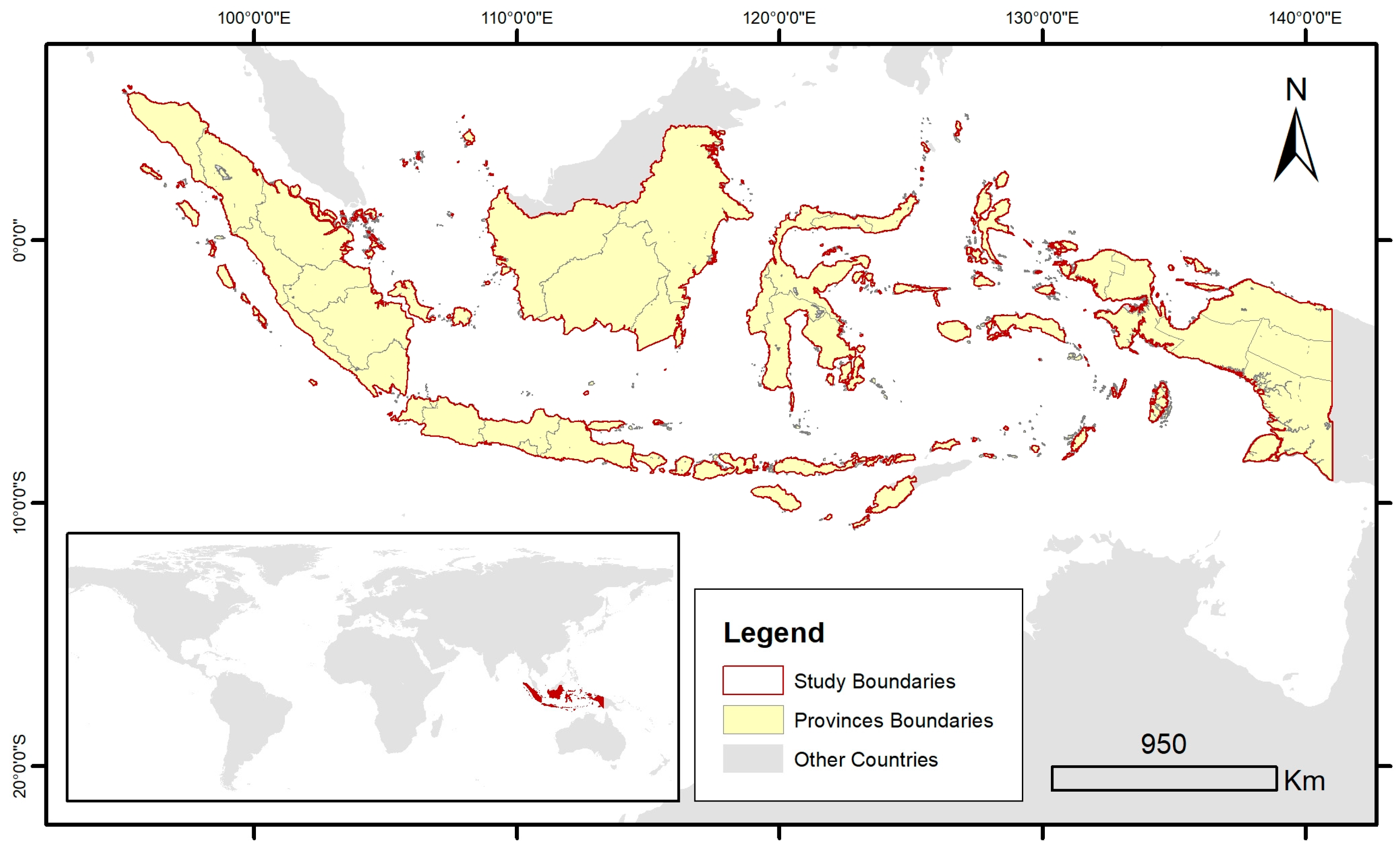
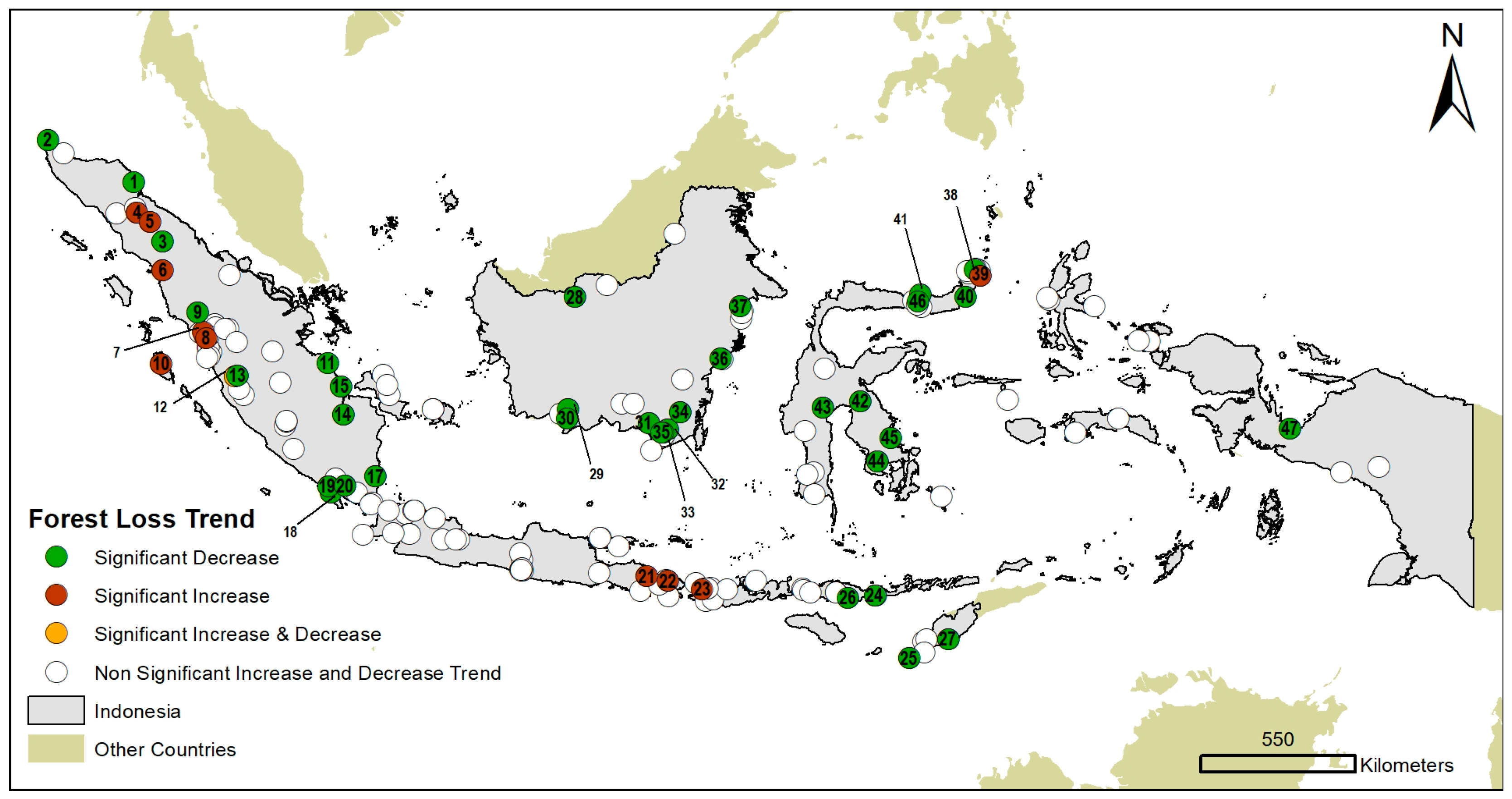
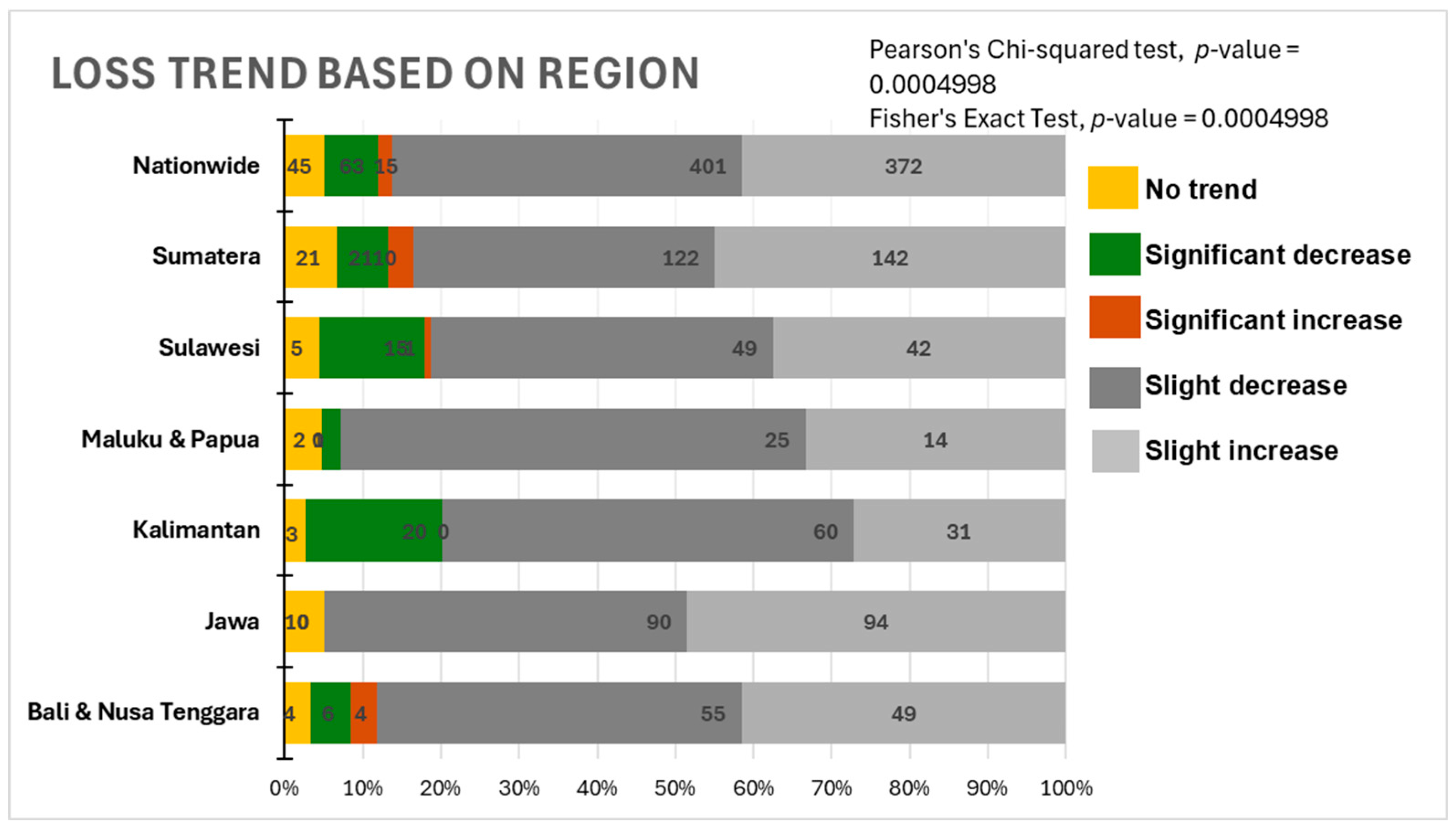


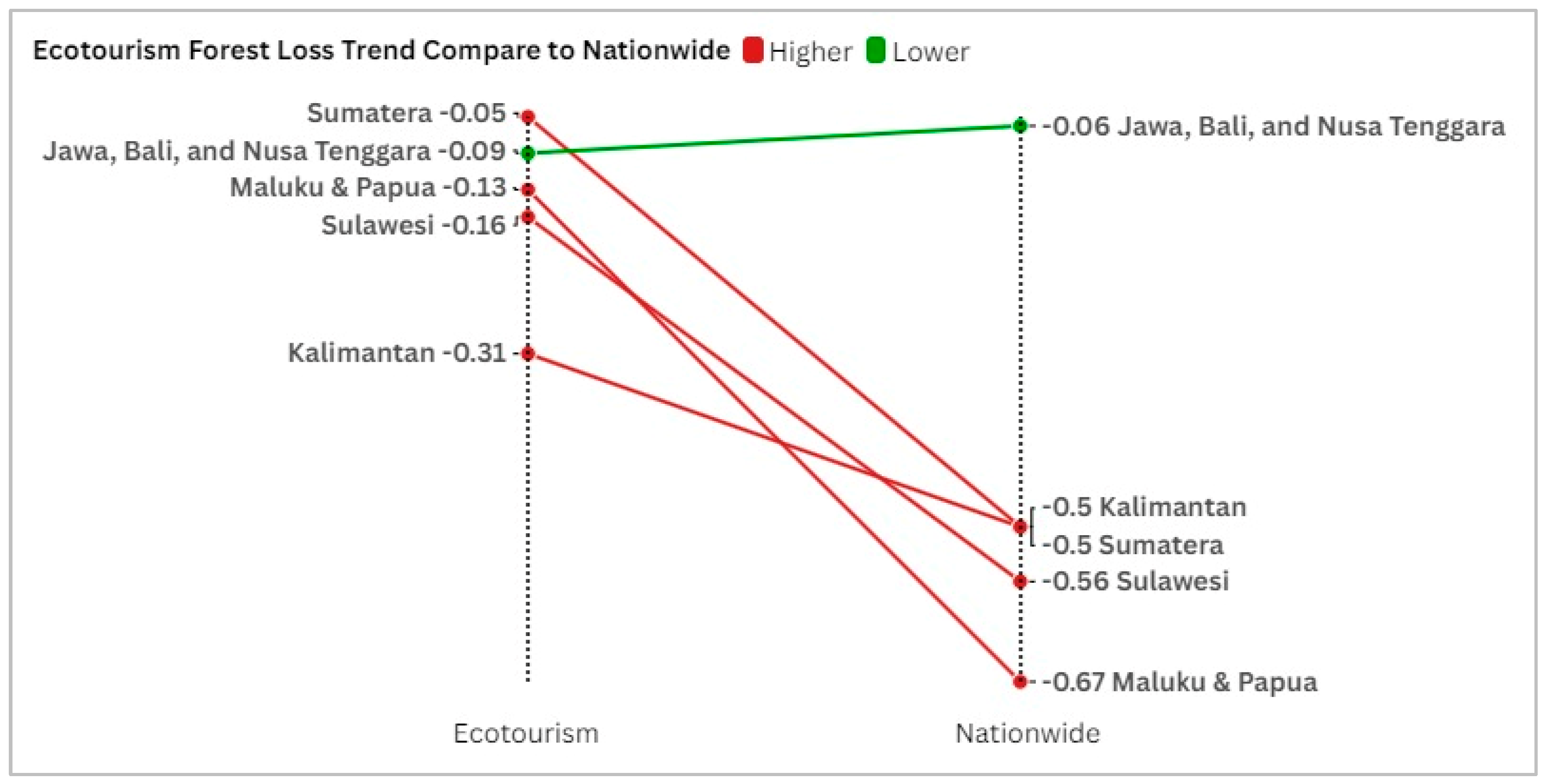
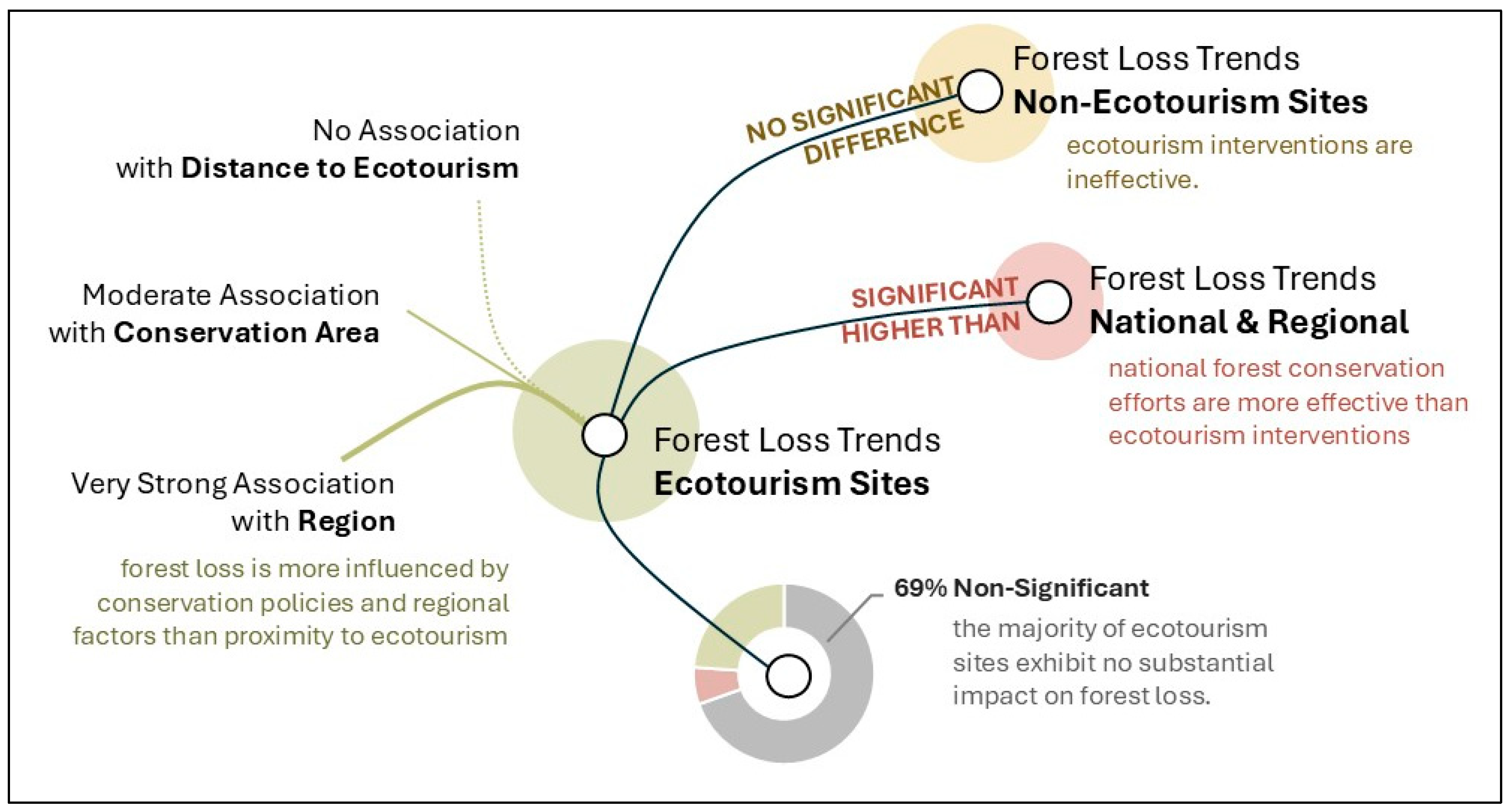
| Kendall’s Tau (τ) | p-Value | Sen’s Slope (b) | Loss Trend |
|---|---|---|---|
| τ > 0 | ≤0.05 | b > 0 | Significant increase |
| τ > 0 | >0.05 | b > 0 | Slight increase |
| τ < 0 | ≤0.05 | b < 0 | Significant decrease |
| τ < 0 | >0.05 | b < 0 | Slight decrease |
| τ = 0 | - | b = 0 | No trend |
| Loss Trend | 1 km | 3 km | 6 km | 9 km | 12 km | 15 km | Ratio |
|---|---|---|---|---|---|---|---|
| Significant increase | 1 | 4 | 3 | 4 | 0 | 3 | 1.6% |
| Slight increase | 34 | 45 | 48 | 40 | 54 | 53 | 30.0% |
| Significant decrease | 2 | 7 | 14 | 15 | 13 | 12 | 6.9% |
| Slight decrease | 60 | 71 | 69 | 74 | 75 | 73 | 46.3% |
| No trend | 7 | 6 | 9 | 10 | 6 | 7 | 4.9% |
| NA | 48 | 19 | 9 | 9 | 4 | 4 | 10.2% |
| No | Variables | Pearson’s Chi-Squared Test | Fisher’s Exact Test | Interpretation | |
|---|---|---|---|---|---|
| x-Squared | p-Value | p-Value | |||
| 1 | Distance to Ecotourism | 18.282 | 0.553 | 0.427 | No association |
| 2 | Conservation Area | 43.795 | 0.042 * | 0.011 * | Moderate association |
| 3 | Region | 72.611 | 0.0004998 *** | 0.0004998 *** | Very strong association |
| Region | p-Value | Interpretation |
|---|---|---|
| Kalimantan | 0.0021 * | Significant difference |
| Jawa, Bali and Nusa Tenggara | 0.933 | No significant difference |
| Maluku and Papua | 0.7612 | No significant difference |
| Sulawesi | 0.8564 | No significant difference |
| Sumatera | 0.2843 | No significant difference |
| All (Nationwide) | 0.5812 | No significant difference |
| Region | Mann–Kendall | Sen Slope | Forest Loss Trend 1 | |
|---|---|---|---|---|
| Tau (τ) | p-Value | |||
| Kalimantan | −0.5 | 0.0763 | −10,361.7 | Slight decrease |
| Maluku and Papua | −0.67 | 0.0164 * | −14,649.7 | Significant decrease |
| Sulawesi | −0.56 | 0.0476 * | −33,173.5 | Significant decrease |
| Sumatera | −0.5 | 0.0763 | −381.211 | Slight decrease |
| Jawa, Bali and Nusa Tenggara | −0.056 | 0.9169 | −117,824 | Slight decrease |
| Nationwide | −0.56 | 0.0476 * | −117,824 | Significant decrease |
Disclaimer/Publisher’s Note: The statements, opinions and data contained in all publications are solely those of the individual author(s) and contributor(s) and not of MDPI and/or the editor(s). MDPI and/or the editor(s) disclaim responsibility for any injury to people or property resulting from any ideas, methods, instructions or products referred to in the content. |
© 2025 by the authors. Licensee MDPI, Basel, Switzerland. This article is an open access article distributed under the terms and conditions of the Creative Commons Attribution (CC BY) license (https://creativecommons.org/licenses/by/4.0/).
Share and Cite
Sisriany, S.; Furuya, K. Does Ecotourism Really Benefit the Environment? A Trend Analysis of Forest Cover Loss in Indonesia. Land 2025, 14, 1237. https://doi.org/10.3390/land14061237
Sisriany S, Furuya K. Does Ecotourism Really Benefit the Environment? A Trend Analysis of Forest Cover Loss in Indonesia. Land. 2025; 14(6):1237. https://doi.org/10.3390/land14061237
Chicago/Turabian StyleSisriany, Saraswati, and Katsunori Furuya. 2025. "Does Ecotourism Really Benefit the Environment? A Trend Analysis of Forest Cover Loss in Indonesia" Land 14, no. 6: 1237. https://doi.org/10.3390/land14061237
APA StyleSisriany, S., & Furuya, K. (2025). Does Ecotourism Really Benefit the Environment? A Trend Analysis of Forest Cover Loss in Indonesia. Land, 14(6), 1237. https://doi.org/10.3390/land14061237









